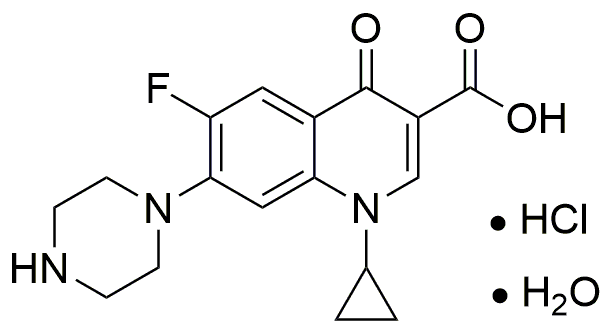Ciprofloxacin hydrochloride monohydrate is widely utilized in research focused on:
- Antibiotic Development: This compound is a key player in the development of broad-spectrum antibiotics, particularly effective against a variety of bacterial infections, making it essential for pharmaceutical research.
- Clinical Applications: It is commonly prescribed for treating respiratory and urinary tract infections, showcasing its importance in the healthcare industry.
- Veterinary Medicine: Ciprofloxacin is also used in veterinary practices to treat infections in animals, highlighting its versatility across species.
- Microbial Resistance Studies: Researchers utilize this compound to study bacterial resistance mechanisms, which is crucial for developing new therapeutic strategies.
- Formulation Development: It serves as a model compound in the formulation of new drug delivery systems, aiding in the advancement of pharmaceutical technology.
General Information
Properties
Safety and Regulations
Applications
Ciprofloxacin hydrochloride monohydrate is widely utilized in research focused on:
- Antibiotic Development: This compound is a key player in the development of broad-spectrum antibiotics, particularly effective against a variety of bacterial infections, making it essential for pharmaceutical research.
- Clinical Applications: It is commonly prescribed for treating respiratory and urinary tract infections, showcasing its importance in the healthcare industry.
- Veterinary Medicine: Ciprofloxacin is also used in veterinary practices to treat infections in animals, highlighting its versatility across species.
- Microbial Resistance Studies: Researchers utilize this compound to study bacterial resistance mechanisms, which is crucial for developing new therapeutic strategies.
- Formulation Development: It serves as a model compound in the formulation of new drug delivery systems, aiding in the advancement of pharmaceutical technology.
Documents
Safety Data Sheets (SDS)
The SDS provides comprehensive safety information on handling, storage, and disposal of the product.
Product Specification (PS)
The PS provides a comprehensive breakdown of the product’s properties, including chemical composition, physical state, purity, and storage requirements. It also details acceptable quality ranges and the product's intended applications.
Certificates of Analysis (COA)
Search for Certificates of Analysis (COA) by entering the products Lot Number. Lot and Batch Numbers can be found on a product’s label following the words ‘Lot’ or ‘Batch’.
*Catalog Number
*Lot Number
Certificates Of Origin (COO)
This COO confirms the country where the product was manufactured, and also details the materials and components used in it and whether it is derived from natural, synthetic, or other specific sources. This certificate may be required for customs, trade, and regulatory compliance.
*Catalog Number
*Lot Number
Safety Data Sheets (SDS)
The SDS provides comprehensive safety information on handling, storage, and disposal of the product.
DownloadProduct Specification (PS)
The PS provides a comprehensive breakdown of the product’s properties, including chemical composition, physical state, purity, and storage requirements. It also details acceptable quality ranges and the product's intended applications.
DownloadCertificates of Analysis (COA)
Search for Certificates of Analysis (COA) by entering the products Lot Number. Lot and Batch Numbers can be found on a product’s label following the words ‘Lot’ or ‘Batch’.
*Catalog Number
*Lot Number
Certificates Of Origin (COO)
This COO confirms the country where the product was manufactured, and also details the materials and components used in it and whether it is derived from natural, synthetic, or other specific sources. This certificate may be required for customs, trade, and regulatory compliance.


